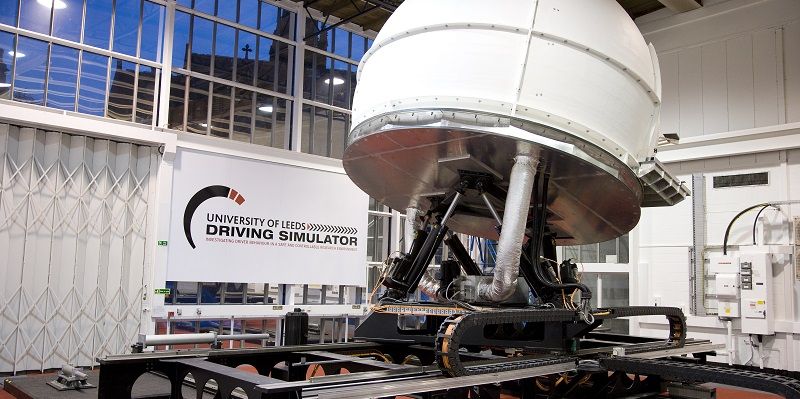
A project researching the latest autonomous vehicle technologies has successfully completed a 230-mile self-navigated journey on UK roads.
The Grand Drive was achieved as part of an investigation into how autonomous driving can emulate a natural, human-like driving style. This consortium project, HumanDrive, included experts from the University of Leeds and was led by Nissan engineers in the UK.
On its journey, the Nissan LEAF test vehicle experienced a range of driving scenarios from country lanes with no or minimal road markings, to junctions, roundabouts and motorways. The autonomous technology activated along the route to change lanes, merge and stop and start when necessary.
Research by the Institute for Transport Studies at Leeds was critical in the development of natural and human-like control systems to create a comfortable and familiar experience for the user during the Grand Drive.
Professor Natasha Merat from the Institute for Transport Studies was the principal investigator for the project research based at Leeds. Professor Richard Romano, also from the Institute for Transport Studies, oversaw the use of the University’s driving simulator, which is part of Leeds’ new Virtuocity centre.
Using the simulator, the Leeds team collected drivers’ behavioural data – what speed they preferred, how they steer, where they position the vehicle on the road. The evaluation of this data was fed back to developers to integrate into the autonomous driving system.
The autonomous driving system was then tested by drivers in the simulator, who fed back in real-time whether they were enjoying their journey and provided additional information about how safe or comfortable they felt.
The researchers also used eye trackers and heart rate monitors to understand drivers’ comfort during their automated travel.
This information was then used to tweak the way the autonomous vehicle drove to mimic a more human-like and realistic style of driving, for use in test-track and real-world testing.
“This project is a shining example of how the automotive industry, working with government, can drive forward technology to benefit people’s mobility – while helping to slash carbon emissions.”
Professor Merat, Chair in Human Factors of Transport Systems at Leeds, said: “The main aim of the project is for the HumanDrive car to travel in a way that is comfortable, natural and ultimately trustworthy for the user.
“While there are many vehicles around the world that have some self-driving features, such as self-parking or cruise control, integrating human-like controllers in automated vehicles will provide a smoother, more comfortable, experience for drivers.
“Our algorithm development is trying to achieve this, along with an understanding of what people want from an automated driving experience.
“Using our state-of-the-art driving simulator, we have spent the past 30 months developing new control models for automated vehicles, using data from a range of participants, which are then evaluated by drivers and compared to a recording of their own drive.”

University of Leeds Driving Simulator
HumanDrive, is jointly funded by the UK government through the Centre for Connected and Autonomous Vehicles (CCAV) and Innovate UK, and nine other consortium partners. The joint funding package for the project totalled £13.5 million.
Business Minister Nadhim Zahawi said: “Safely completing the longest autonomous drive in Britain is an incredible achievement for Nissan and the HumanDrive consortium, and a huge step towards the rollout of driverless cars on UK streets.
“This project is a shining example of how the automotive industry, working with government, can drive forward technology to benefit people’s mobility - while helping to slash carbon emissions.”
Future of Transport Minister George Freeman said: “The UK is fast becoming a leader in intelligent and automated vehicle and traffic management technology, a huge global sector set to create thousands of jobs.
“Our Future of Mobility: Urban Strategy is supporting transport innovation for cleaner, greener and smarter transport, and Nissan’s successful HumanDrive project is an exciting example of how the next phase of the UK’s transport revolution could look.”
Using immersive virtual reality
Professor Romano, Chair in Driving Simulation at Leeds, said: “Underpinning the HumanDrive car’s automation is our team’s analysis of studies from drivers on the road and in our simulation.
"These identify characteristics of natural driving and risk factors which influence driver behaviour and were used to develop a control model capable of mimicking how a human driver reacts to risks in real-time.
“The studies undertaken at the University of Leeds Driving Simulator help us to understand the degree to which drivers prefer an autonomous driving style that is human-like and if they prefer a style that mimics their own. This informs how human-like and how personal an autonomous vehicle should behave.”
“This project highlights the capabilities of Leeds’ new Virtuocity centre, and its ability to integrate externally-developed automated vehicle control software in the simulation environment and rapidly generate geo-specific databases and perform simulation-based testing of driverless cars.”
The driving simulator is only one of the simulators in Virtuocity that uses immersive virtual reality to conduct research that can improve the design of urban transport and city systems.
The HIKER lab, the largest cave based pedestrian simulator in the world, was recently unveiled as part of Virtuocity, joining the driving and truck simulators.
Virtuocity’s driving and pedestrian simulation laboratories will be connected to create a single “multi-player” environment enabling researchers to address complex questions including how driverless vehicles will interact with their passengers and with pedestrians.
Further information
For media enquiries email the University of Leeds Press Office at pressoffice@leeds.ac.uk.